One of the main reasons we’d made the tedious journey to Iceland (from the Netherlands) was to catch the northern lights. However, the higher the hope, the greater the disappointment. With this in mind, I tried to contain my expectations and kept reminding my travel companion that the chance of seeing the northern lights was at best, 50/50 (this is true, by the way).
Most people usually sign up for northern lights tours simply because the ideal locations to view the lights need to be far away from any light pollution, i.e. cities. Therefore, a tour provides the needed transport as well as the expertise of having scouts driving around to chase the lights for us. I personally won’t recommend driving by yourself because of the total darkness and snow, if you are visiting in the depth of winter.
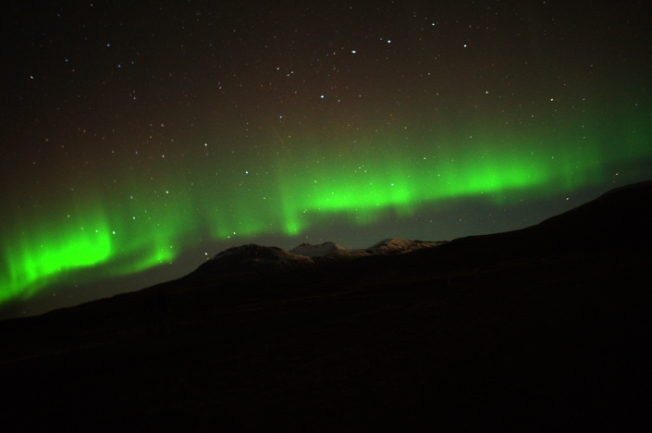
We signed up for a tour by Sterna Travels for the first night that we would be spending in Iceland a week beforehand , costing ISK5510/pax. However, at around 4pm, the tour company phoned to inform us that the tour would have to be postponed to the next night due to total cloud cover which would make it impossible to view the aurora, even if it were dancing in the sky right above the clouds. We were slightly disappointed but comforted ourselves that we still had 3 more nights in Iceland to spare. However, we would still need to be incredibly lucky to be able to catch the lights. The girl who was in the same hostel dorm said that she had spent the entire past week in Iceland and failed to catch the aurora throughout
There are several websites which publish aurora forecasts for public use and one of them is http://en.vedur.is/weather/forecasts/aurora/. People have said that they are pretty accurate especially for the 24-hour outlook, but then again a forecast is ultimately a prediction and might not be reflective of reality. On the two nights that we saw the auroras, the forecast was a 0 out of 9! But I would still advise one to check the website regularly as the forecast changes frequently. It does provide a rough gauge of your chances for that night.
On the second day of our Iceland adventure, the tour company called us to confirm that the tour was on! This wasn’t surprising given that the day that we had spent touring Reykjanes Peninsula had been totally cloud-free. Excitement begin to churn within me and it refused to be dampened by my attempts to quell my excitement. As we knew that the tour would end late, we decided to bathe first so that we could hit the sack immediately upon returning to the hostel after the tour.
The minibus first picked us up from the doorstep of our hostel at 8.30pm, before proceeding to a large bus stop in the centre of Reykjavik where some sorting and shuffling of people were done between the two minibuses. I suspect it is mainly to aid the return trip back to our respective accommodations. Finally, at 9.30pm, we could finally set off!
We drove into the countryside and once it got totally dark outside, the tour guide told us that we could start looking out for the lights now. Everyone started craning their necks, trying to get a glimpse of the night sky from the bus windows. However, it wasn’t an easy task as there was a lot of reflection from the internal lighting of the bus on the windows, preventing us from getting a good view.
At around 10pm, a slight commotion arose when people spotted a greyish cloud-like object floating in the sky on the left side of the bus. I had been staring at that cloud for the past 10 minutes and had suspected that it MIGHT be a weak aurora, as I had read online that a weak aurora would look something like a cloud. The guide became excited and the minibus soon found a place to park in the field.
We poured out of the minibus into the cold. People started gazing out into the sky, trying hard to spot the lights. I quickly set up my tripod and camera. It was so dark, I could hardly see to fit my camera onto the tripod. My friend tried to lend a helping hand but we were both equally useless at fumbling around in the dark! Finally, to confirm my suspicions, I aimed my camera at the ‘cloud’ and pressed the shutter.
This was the result. It literally took my breath away!
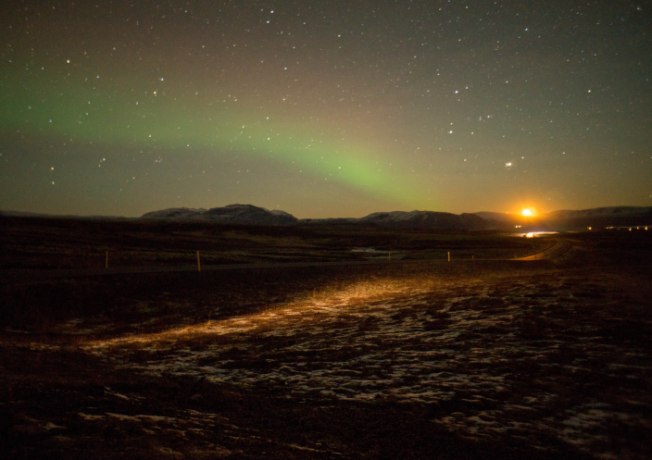
I quickly showed the photo to the guide, who confirmed that I had captured a weak aurora, which usually indicated the beginnings of an aurora display. Immediately, a crowd of fellow tourists swamped me, asking to take a look at the photo, for they simply could not see the colourful spectre as portrayed by my camera with their naked eyes. What they could see was merely a grey cloud.
We lingered in the area for a while more, before the tour guide decided to bring us to another location where we could hopefully get a better view of the Lights.
After a 10 minute drive, the driver parked the bus and we once again poured out onto the field, raring to see the lights. And to our pleasant surprise, the lights were now in full force. Curtains, which glowed a pale green, hung silently over us. The group stood in silence for a few minutes, just enjoying the moment and the serenity. Witnessing such an incredible natural phenomenon was a truly mind-blowing event.
Having read online that the northern lights could stretch from anywhere between 5 minutes to 3 hours, I wasted no time in setting up my camera to capture the auroras. Due to the long exposure time required (about 15-20 seconds), I had plenty of time in between taking photos to admire the auroras with my own two eyes. Granted, the auroras looked a lot more brilliant and vibrant on camera than with the naked eye (given that it was only graded as moderate), but it is impossible to forget the sight of the lights drifting soundlessly above us. One really has to experience it to realise how deeply seeing the auroras in person affects him/her.
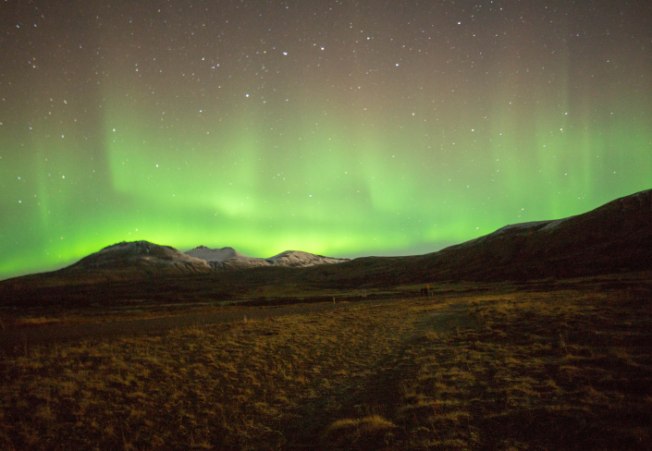
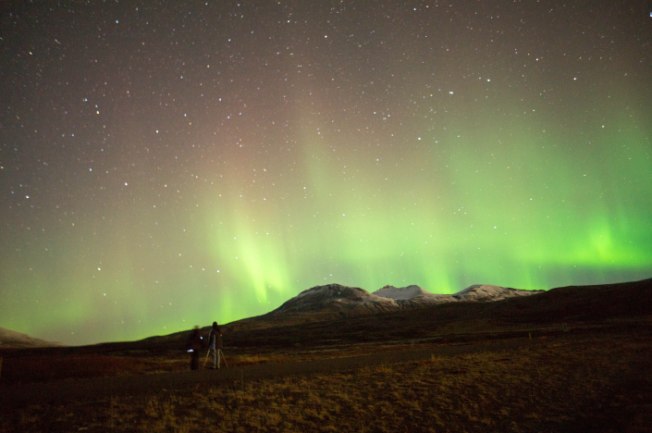
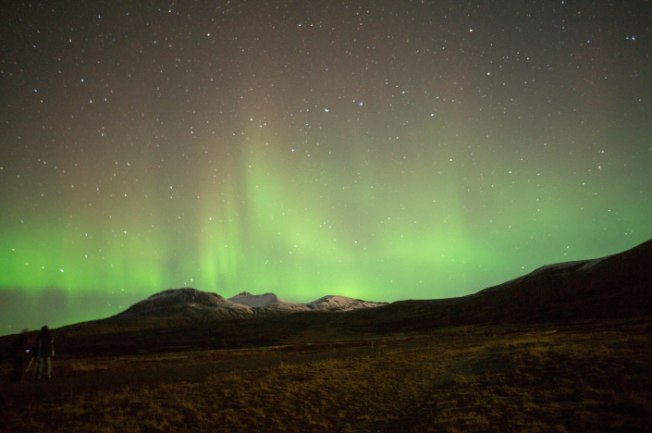
The full moon didn’t detract us from seeing the Northern Lights in all its glory. In fact, it complemented the auroras and lit up the landscape, giving it a mysterious aura.
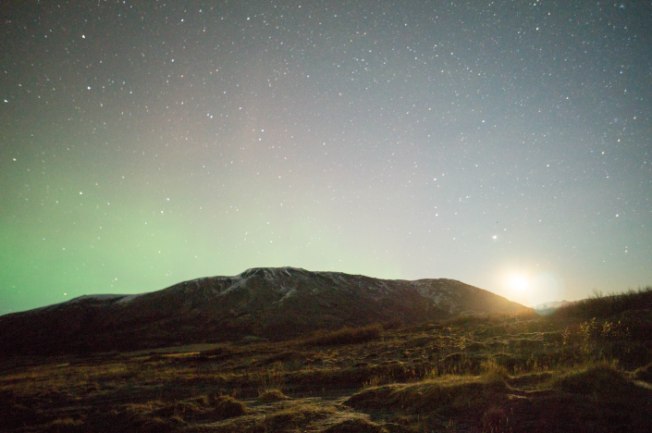
Hot chocolate was served to us midway during the aurora-gazing. It was very comforting (in Singlish speak, shiok!) to be able to sip the hot chocolate and warm our cold bodies up. Although we were lucky that it was a windless night, standing in the cold for more than 10 minutes is also very demanding. I could hardly feel my extremities by the time we returned to the bus at the end! So do make sure to dress warmly. Down jackets, thermal underwear, scarfs, beanies and wool socks are crucial to staying warm and comfortable throughout the tour. The coach will usually stay open and heated throughout the viewing so as to offer tourists a refuge from the cold.
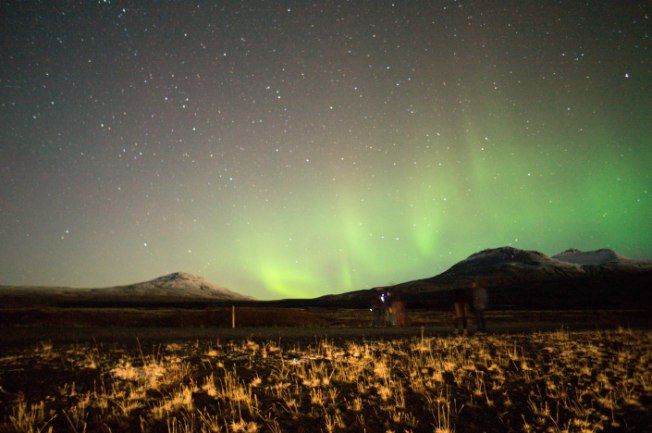
Taking Photos of the Northern Lights
I researched extensively about how to take photos of the northern lights, and took away some pointers, which I will summarise below.
Camera specifications
- Aperture f2.8
- Wide-angled lens (24mm)
- Exposure comp. +3.0
- ISO 800
- Optional: Save photo in RAW format (for better manipulation with photo-editing software such as Lightroom)
- Remove any filters as they might affect the clarity of the auroras (for DSLRs)
My camera was a compact mirrorless camera (Sony NEX f3) rather than a full-fledged DSLR. As long as the camera gives you the flexibility to adjust exposure timings, it is sufficient to capture the auroras.
Additionally, it is advised that a cable release button should be used to capture photos so that one can avoid touching the camera at all and thus maintain extreme stability. As I didn’t have such a product, I chose to set a timer instead, so that when the shutter is first released, my hands would not be disturbing the camera.
Never ever try to use the flash on your camera! It is impossible to capture light with light, plus some serious photographers might get annoyed with people using flash photography as the unwelcome flashes interfere with their long exposure shots. I’ve read online accounts of how people said they got yelled at because they used the flash on their compact cameras.
- A tripod is essential due to the long exposure times (15-20 seconds) required to shoot each photo, and your hands can’t stay that steady that long which will result in a blur photo. Long exposure times means the camera’s shutter stays open for a longer time in order to let in more light, thus enhancing the aurora. This is not as necessary if the auroras are really active.
- Best if the tripod is sturdy, because the Icelandic winds can be really strong and you don’t want your tripod and attached camera to tip over and shatter.
Small Torchlight
- I had some struggles fixing my camera on the tripod due to the darkness. A small torchlight (either a standalone one or from a mobile phone) would come in handy here. Just be careful not to shine the light at anyone else as it can be irritating and be a source of light pollution.
(Partially) Clear Skies
- As mentioned earlier, without this important element, one can forget about viewing the Northern Lights, let alone taking photos of them.
Solar Activity
- One can have clear skies and not a single aurora to be seen, as the appearance of the aurora depends on solar activity as well. A consolation prize is the viewing of all the amazing star constellations which a city person would hardly see in his/her hometown.
There were quite a few people who did not have the appropriate equipment to capture photos of the Northern Lights. I instantly become popular among them when they realised how nicely the auroras turned out on my camera. A few of them requested for me to email some photos to them, which I agreed. I think one of them, an elderly Caucasian, was so grateful that she brought me an extra cup of hot chocolate while I was busy taking photos. 🙂 It was really sweet of her to do so!
When midnight drew nearer, the aurora faded away and we headed back to the minibus, cold but happy. 🙂 This was truly the experience of a lifetime!

2 Comments
Oh wow, thank you for such useful tips.
You are most welcome 🙂 thank you for your kind words!